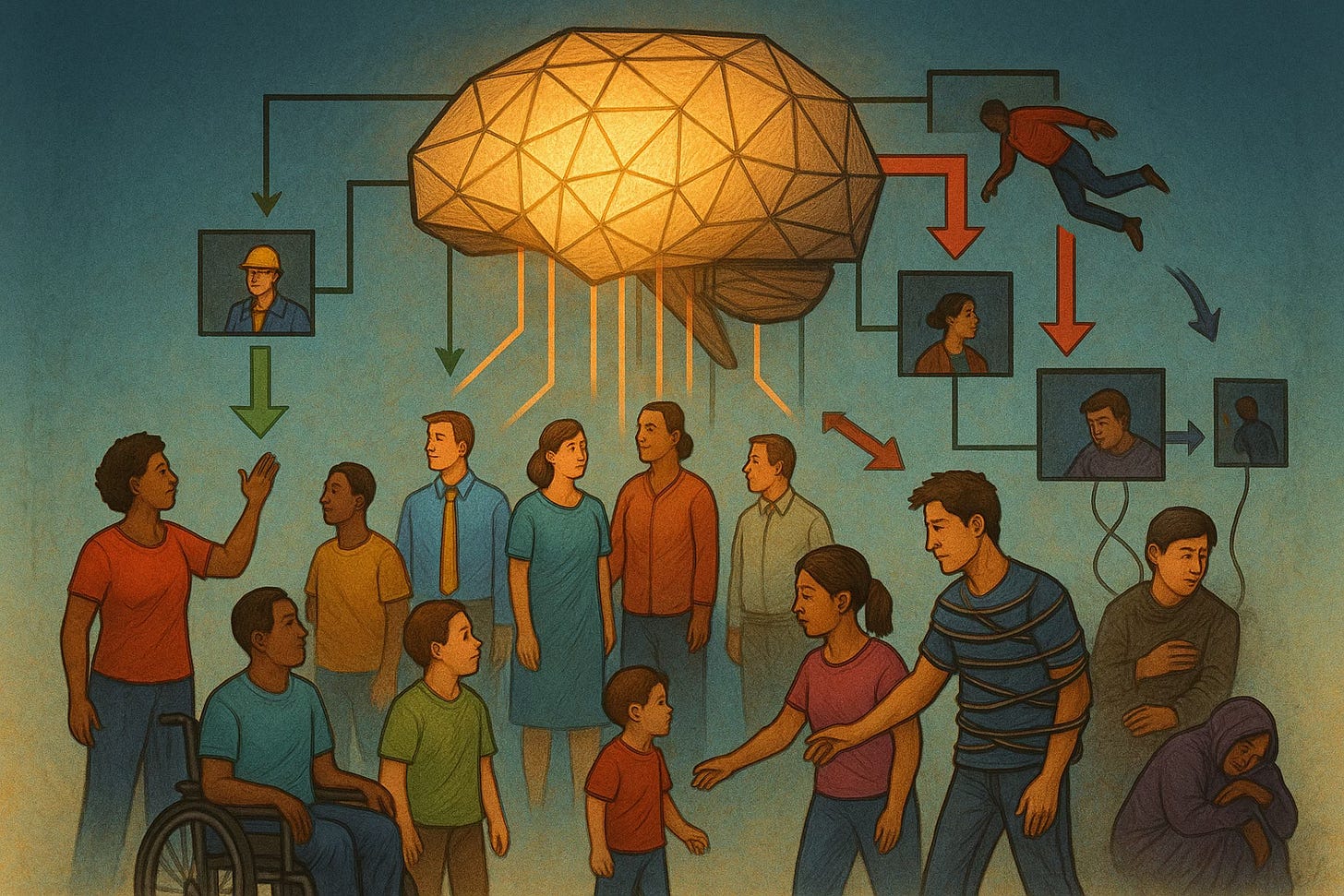Metasymbolic Mirroring and Collective Reflexivity
A Framework for Social Holon Transformation
EXECUTIVE SUMMARY:
In every community, organization, or social system — what we can call a social holon — there’s more happening beneath the surface than we usually see. It’s not just people and structures; it’s an emergent, collective intelligence: the living pattern that organizes how we assign roles, manage tensions, and maintain coherence as a whole.
But here’s the challenge: to stay coherent, the system often sorts difference using symbolic markers like race, class, gender, or status — deciding, often unconsciously, who gets centered, who gets marginalized, and who gets used in particular roles. This is how systems generate patterns like hierarchy, exclusion, and even racism — not always because anyone chooses to, but because the deeper logic of the system pushes in that direction.
Metasymbolic mirroring is a practice I’ve been developing to help make these invisible patterns visible. By analyzing the symbolic dynamics of group texts, conversations, or actions — looking at roles, tensions, and relational positioning (without trying to “tag” people’s identities) — we can hold up a kind of mirror for the group.
This mirror helps the collective see: How are we using difference? How are we organizing ourselves? Where might we want to transform?
The goal is not to break the system, but to help it evolve — toward greater justice, adaptability, and resilience, without collapsing into chaos or rigid control. It’s a way of helping the whole become more whole.
INTRODUCTION
Social systems are not merely collections of individuals or institutions; they are social holons — emergent, embodied entities composed of material elements (members, infrastructures, subgroups), symbolic architectures (roles, meanings, markers, norms), and a distributed collective intelligence — the adaptive, self-organizing logic that enables the holon to coordinate its parts as a coherent whole.
This collective intelligence is not reducible to individual actors or structures; it arises from relational dynamics, symbolic operations, and communicative flows, shaping how the holon differentiates its elements, assigns functions, navigates tensions, and maintains coherence across time.
Understanding the dynamics of social holons offers a way to see beyond surface-level events and grasp the deeper symbolic architectures that generate both order and dysfunction in collective life.
THE DYNAMICS OF SOCIAL HOLONS
For a social holon to survive and persist, it must sort, transform, and coordinate its members and subunits into differentiated roles. Symbolic markers — such as race, class, gender, caste, ability, lineage, or cultural codes — serve as tools for the system to:
assess adaptability,
predict function,
allocate positions,
and manage inclusion or exclusion.
Importantly, marginalization is not the only outcome; many members are not excluded but selectively incorporated into particular roles, often under symbolic codes that define their use or limit their agency. This produces a differentiated functional ecology in which some are centralized, others functionalized, and others marginalized or expelled.
Examples:
In organizations, workers may be sorted by cultural fit or social capital, not just job title.
In racialized systems, individuals may be differentially integrated or excluded along lines of perceived identity.
In religious or ideological groups, participants may be positioned by symbolic authority, lineage, or charismatic legitimacy.
These symbolic-operational patterns are not merely reflective; they are constitutive of how the holon enacts itself.
ANOMIE AND KINETIC DYSFUNCTIONS
When inherited symbolic logics become rigid, extractive, or oppressive, there is often a push to dismantle them. But deconstructing symbolic systems without scaffolding risks triggering anomie — a condition of normlessness, disorientation, and loss of shared meaning (Durkheim).
Anomie can then give rise to secondary dysfunctions, including:
Collapse: dissolution into isolated fragments.
Bifurcation: splitting into polarized factions.
Oscillation: chaotic swings between disorder and overcontrol.
Authoritarian snapback: rigid reassertion of hierarchy to restore order.
Pathological innovation: maladaptive social experiments.
This is why transformation must be approached with care — not as dismantling coherence, but as evolving it.
RACISM AS SYMBOLIC-OPERATIONAL SORTING
At its core, racism is not just prejudice or bias; it is a symbolic-operational system through which the collective intelligence of a holon sorts, assigns, and instrumentalizes human difference into hierarchies of value and function.
Race — as a socially constructed marker — becomes a tool to:
assign roles,
predict social use,
manage incorporation or exclusion.
For example:
Certain groups may be symbolically coded as “resilient,” “dangerous,” “subordinate,” or “sacrificial,” shaping how they are included, excluded, or functionalized.
Even positive-sounding attributions can become instrumentalizing, locking groups into system-serving roles.
These patterns become self-reinforcing over time, embedding themselves not just in institutions but in the holon’s symbolic architecture. Without collective reflexivity, the system becomes unable to integrate difference without domination.
METASYMBOLIC MIRRORING: A TOOL FOR COLLECTIVE REFLEXIVITY
Metasymbolic mirroring is a practice designed to help social holons reflect on their own symbolic-processual dynamics. It works by:
analyzing texts, discourses, enactments, and social patterns,
surfacing archetypal roles, symbolic tensions, and relational positions,
and holding up these insights as a mirror for collective reflection.
Importantly, metasymbolic mirroring does not directly tag or identify individuals’ intersectional identities (such as race, class, gender, ability) from text.
Instead, it attends to relational patterning — how difference is marked, positioned, and symbolically operationalized within the system.
For example:
Who is consistently positioned as insider or outsider, central or peripheral, authority or disruption?
What symbolic oppositions (e.g., unity/difference, purity/impurity, innovation/tradition) organize tensions?
How does the holon differentially incorporate or marginalize certain kinds of voices, whether or not their social identities are explicitly named?
This focus on relational markers and symbolic patterns allows metasymbolic mirroring to respect the limits of textual inference, avoiding reductive or error-prone “identity tagging,” while still illuminating the deep architectures through which social differentiation operates.
EXAMPLE: METASYMBOLIC ANALYSIS AI PROMPTS
The metasymbolic analysis prompts I am developing guide analysts (human or AI-assisted) to:
Identify archetypal roles (e.g., Leader, Rebel, Caregiver, Trickster, Gatekeeper),
Map symbolic tensions (e.g., inclusion/exclusion, order/disruption, center/periphery),
Surface relational patterns (who is positioned where, and how power, value, and legitimacy flow),
Without attempting to extract or label individuals’ social identities.
For example, in a community dialogue, the analysis might reveal:
Who is consistently given legitimacy or voice,
Who carries symbolic burdens (such as moral outrage, innovation pressure, or sacrifice),
How tensions are clustering,
And how difference is operationalized at the group level.
These outputs are then fed back to the group as mirrors — not judgments or solutions, but invitations for collective reflexivity.
TOWARD TRANSFORMATIVE ADAPTATION
The goal is not to dissolve the holon or erase symbolic differentiation altogether, but to elevate its collective intelligence so it can shift:
from fixed role assignment to dynamic capacity,
from instrumentalization of difference to mutual recognition,
from rigid coherence to adaptive, plural coordination.
This is a path toward transformation that does not court collapse — a path of higher-order adaptation in which the holon becomes more resilient, reflexive, and just.
CONCLUSION
In a time when social systems face unprecedented strain, metasymbolic mirroring offers a practice of collective self-awareness. By surfacing the invisible architectures of symbolic differentiation, role assignment, and relational patterning, it invites holons to reflect, re-symbolize, and evolve.
Importantly, it does this without claiming to know or assign the intersectional identities of individuals, focusing instead on the relational and systemic patterns in play. This allows for ethically responsible analysis while opening the door to transformative adaptation.
In short, metasymbolic mirroring helps social holons not only survive, but become — to become more fully what they are: living, becoming wholes capable of integrating difference without domination.
This image depicts a solitary figure standing on a hill, gazing up at a luminous, branching tree made of interconnected lines and nodes, glowing against a vast cosmic sky.
The tree represents the social holon itself:
its branching complexity,
its interwoven relationships,
its emergent, living intelligence.
The radiance symbolizes the act of illumination — the moment when the holon, through metasymbolic mirroring, gains sight of its own hidden architectures: the patterns of sorting, role assignment, marginalization, and incorporation that shape its becoming.
The solitary figure at the base is us — or any one of us — standing before the vast, often invisible collective intelligence we are part of. This figure also symbolizes the emergence of reflexivity: the moment when part of the holon turns to face the whole and begins to see, wonder, and participate consciously.
The cosmic backdrop reminds us that these processes are not merely institutional or organizational — they are evolutionary, existential, and symbolic. They belong to the great project of how human beings live together, become together, and evolve together.
In relation to the essay, this image beautifully captures the central theme:
That through metasymbolic mirroring, a social holon can become more than a system managing difference — it can become a reflexive, adaptive, evolving whole, capable of integrating difference without domination and transforming itself toward greater justice, resilience, and wholeness.
✦ AUTHORSHIP STATEMENT
This paper was authored by Joseph Camosy, with the assistance of OpenAI’s ChatGPT as an interactive research, drafting, and synthesis tool. The intellectual framework, theoretical contributions, critiques, and direction of the work were provided and guided by Joseph Camosy. ChatGPT supported the writing process by helping to articulate concepts, organize sections, propose formulations, and iterate drafts in dialogue with the author.
While AI provided meaningful assistance in shaping the document, authorship rests solely with Joseph Camosy. AI is acknowledged here as a tool, not a co-author, as it does not possess agency, intellectual responsibility, or the capacity for original authorship.
This work reflects a collaboration between human creativity and machine-assisted drafting, with the final responsibility and intellectual ownership held by the human author.



